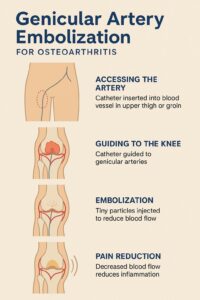Osteoarthritis (OA) of the knee is one of the most common causes of chronic knee pain, affecting millions of people worldwide. When the protective cartilage in the knee wears down, bones begin to rub together, leading to pain, stiffness, swelling, and reduced mobility.
While many patients find relief with medications, injections, or physical therapy, some continue to experience daily discomfort. For these individuals, Genicular Artery Embolization (GAE) offers a promising, minimally invasive option for long-lasting pain relief.

GAE is a minimally invasive procedure designed to reduce pain and inflammation in the knee caused by osteoarthritis. It works by blocking abnormal blood flow to the inflamed lining of the knee joint (synovium).
By reducing this excess blood supply, inflammation decreases, and pain often improves — without the need for open surgery.
1. Accessing the Artery – A specially trained interventional radiologist inserts a thin, flexible tube (catheter) into a blood vessel in the upper thigh or groin.
2. Guiding to the Knee – Using advanced imaging technology, the catheter is guided to the genicular arteries — the small blood vessels supplying the knee joint.
3. Embolization – Tiny, medical-grade particles are injected to block these vessels and reduce blood flow to inflamed areas.
4. Pain Reduction – With reduced inflammation, patients often experience a gradual but significant improvement in knee pain and mobility.
GAE may be an option for patients who:
Most patients go home the same day and notice pain improvement within days to weeks. Some experience gradual improvement over several months as inflammation continues to decrease.
Mild soreness or bruising at the access site is normal and usually resolves quickly. Your care team will provide activity guidelines and follow-up appointments to track your recovery.
GAE is generally well-tolerated, with a low risk of complications when performed by an experienced specialist. Side effects are usually mild and temporary. Your physician will discuss any potential risks before the procedure.
If knee osteoarthritis is interfering with your daily life and other treatments haven’t worked, Genicular Artery Embolization may be worth considering. This innovative, minimally invasive procedure offers hope for reducing pain, improving mobility, and getting back to the activities you enjoy.
📅 Interested in learning more? Schedule a consultation with our team to see if GAE is right for you. 661-324-4100
© Copyright 2024 Vascular Health Partners LLC. All Rights Reserved
Designed By CyberWorx